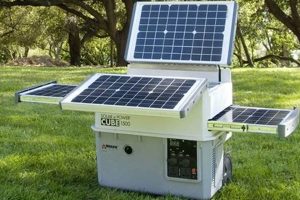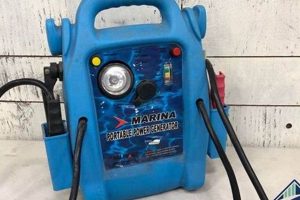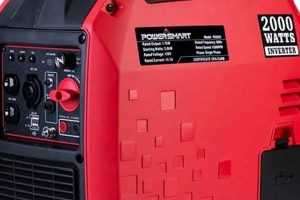A compact, independent power source built using readily available components and fueled by sunlight offers a versatile solution for off-grid energy needs. Such systems typically involve photovoltaic panels to capture solar energy, a charge controller to regulate the current, a battery for storage, and an inverter to convert the stored direct current (DC) electricity into alternating current (AC) for powering standard devices. An example might include a system designed to power laptops, smartphones, and small appliances during camping trips or in emergencies.
Self-built power solutions provide energy independence and resilience, particularly valuable in remote areas or during power outages. Historically, access to reliable electricity has often been tied to established infrastructure. The development of smaller, more efficient solar panels and battery technology has democratized power generation, allowing individuals greater control over their energy access. This empowers individuals to mitigate the impacts of rising energy costs and contribute to sustainable energy practices.
The subsequent sections will delve into the core components required for constructing a personal power system, explore various design considerations, and provide guidance on selecting the appropriate materials for specific energy requirements. Furthermore, safety precautions and best practices for assembly and operation will be addressed.
Tips for Constructing a Personal Solar Power System
Careful planning and component selection are essential for creating a safe and effective independent power source. The following tips offer guidance throughout the construction process.
Tip 1: Accurately Assess Power Requirements. Calculate the total wattage needed to power the intended devices. This information determines the necessary solar panel capacity and battery storage.
Tip 2: Prioritize Quality Components. Durable solar panels, charge controllers, and batteries ensure system longevity and optimal performance. Research reputable manufacturers and prioritize efficiency ratings.
Tip 3: Understand Battery Chemistry. Different battery types offer varying lifespans, charging characteristics, and safety profiles. Lithium-ion batteries often provide higher energy density, while deep-cycle lead-acid batteries offer a more cost-effective solution.
Tip 4: Employ Proper Wiring Techniques. Correctly sized wiring and secure connections minimize energy loss and prevent overheating. Consult wiring diagrams specific to the chosen components.
Tip 5: Incorporate Safety Features. Include fuses, circuit breakers, and proper grounding to protect the system and prevent electrical hazards. Adherence to safety standards is paramount.
Tip 6: Consider Environmental Factors. Account for the average sunlight hours in the intended location when sizing the solar panel array. Enclosure design should protect components from weather exposure.
Tip 7: Test and Monitor System Performance. After assembly, thoroughly test the system under various load conditions. Regularly monitor battery voltage and current output to ensure optimal operation and identify potential issues.
Adhering to these guidelines facilitates the construction of a reliable and safe personal power solution tailored to specific energy needs. Careful planning and execution are essential for maximizing system efficiency and longevity.
By understanding the core principles of solar energy harvesting and applying these practical tips, individuals can achieve greater energy independence and contribute to a more sustainable future. The following section will offer a concluding perspective on the broader implications of personal power generation.
1. Power Needs
Accurately determining power consumption requirements forms the foundation of a successful portable solar power generator project. This crucial initial step directly influences the selection and sizing of all other components, impacting both system performance and overall cost. Underestimating power needs results in an underpowered system unable to meet demands, while overestimating leads to unnecessary expenses and potentially excessive weight and bulk. A clear understanding of energy requirements is therefore essential for optimizing the design and ensuring the system’s practical utility.
Consider a scenario involving powering essential devices during a power outage. A user might need to operate a laptop (60W), a small refrigerator (150W), and several LED lights (20W total). Calculating the combined wattage (230W) provides a baseline for determining the necessary solar panel wattage and battery capacity. Further considerations include the duration of use for each device and the expected hours of sunlight available for recharging. This practical example illustrates how specific power needs directly translate into component specifications.
Successfully matching power production to consumption requires careful consideration of peak loads, average usage, and potential future expansion. Accurately assessing these factors is crucial for designing a system capable of meeting current demands while remaining adaptable to future needs. Failure to adequately address power needs can lead to system inefficiencies, inadequate performance, and ultimately, the failure of the project to meet its intended purpose. Understanding this fundamental connection between power needs and system design is paramount for achieving a functional and practical portable power solution.
2. Component Selection
Component selection is paramount in constructing a functional and efficient portable solar power generator. Each component plays a crucial role in the system’s performance, reliability, and longevity. Careful consideration of specifications, quality, and compatibility is essential for a successful build. Choosing appropriate components ensures efficient energy capture, storage, and conversion, ultimately determining the system’s effectiveness in meeting power demands.
- Solar Panels
Solar panels are the foundation of the system, converting sunlight into electricity. Monocrystalline panels offer higher efficiency but come at a premium cost, while polycrystalline panels provide a balance between cost and performance. Flexible thin-film panels are lightweight and adaptable but less efficient. Choosing the right panel type depends on factors like available space, budget, and desired power output. A high-quality panel with appropriate wattage ensures optimal energy capture, directly impacting the system’s ability to meet power needs.
- Charge Controller
Charge controllers regulate the flow of electricity from the solar panels to the battery, preventing overcharging and maximizing battery lifespan. Pulse Width Modulation (PWM) controllers are cost-effective, while Maximum Power Point Tracking (MPPT) controllers are more efficient, especially in varying light conditions. Selecting the appropriate charge controller is critical for battery health and overall system efficiency. A poorly matched controller can lead to reduced battery life or inefficient charging, hindering the system’s performance.
- Battery
Batteries store the generated electricity for use when sunlight is unavailable. Deep-cycle lead-acid batteries are a cost-effective option, while lithium-ion batteries offer higher energy density and longer lifespans. Battery capacity, measured in ampere-hours (Ah), determines the amount of energy that can be stored. Choosing the correct battery type and capacity is essential for meeting power demands and ensuring reliable operation. An inadequate battery capacity will limit the system’s runtime, while an oversized battery adds unnecessary weight and cost.
- Inverter
Inverters convert the DC electricity stored in the battery to AC electricity, enabling the use of standard household appliances. Pure sine wave inverters provide cleaner power, suitable for sensitive electronics, while modified sine wave inverters are a more budget-friendly option for less sensitive devices. Inverter power rating must match the combined wattage of the devices to be powered. Selecting the right inverter is essential for compatibility and safe operation of connected devices. Using an underpowered inverter can lead to overloading and potential damage to both the inverter and connected equipment.
Careful component selection, based on individual power needs and budget, is crucial for building a successful portable solar power generator. The interplay between these components directly influences the system’s overall performance, reliability, and longevity. Balancing cost, efficiency, and performance across all components ensures a functional and practical system capable of meeting the intended power demands. Ignoring the nuances of component selection can lead to an underperforming, unreliable, or even unsafe system. Therefore, a comprehensive understanding of each component’s role and specifications is essential for a successful DIY project.
3. Battery Chemistry
Battery chemistry is a critical factor in portable solar power generator design, directly influencing performance, lifespan, safety, and cost. Selecting the appropriate battery chemistry requires careful consideration of the specific application and anticipated usage patterns. Understanding the characteristics of different battery chemistries is essential for optimizing system performance and ensuring safe and reliable operation.
- Lead-Acid Batteries
Lead-acid batteries, particularly deep-cycle variants, are a common choice due to their affordability and wide availability. They offer a robust and reliable solution, well-suited for applications requiring high current delivery. However, they are heavier and have a lower energy density compared to other chemistries. A typical example is their use in off-grid solar systems for powering lights and appliances. While cost-effective, their weight and limited lifespan can be drawbacks for highly portable applications.
- Lithium-ion Batteries
Lithium-ion batteries have gained popularity due to their high energy density, lightweight nature, and longer lifespan. They are well-suited for portable applications where weight and size are critical considerations. Examples include powering laptops, smartphones, and portable power tools. While they offer superior performance, lithium-ion batteries are more expensive than lead-acid and require specialized charging circuitry for safety.
- Lithium Iron Phosphate (LiFePO4) Batteries
LiFePO4 batteries represent a subset of lithium-ion technology offering enhanced safety and cycle life. They are more tolerant to overcharging and less prone to thermal runaway, making them a safer option. They are increasingly used in portable power stations and electric vehicles. While they offer significant safety advantages, LiFePO4 batteries typically have a lower energy density compared to other lithium-ion variants.
- Nickel-Metal Hydride (NiMH) Batteries
NiMH batteries offer a moderate energy density and are less toxic than some other chemistries. They were commonly used in portable devices before the rise of lithium-ion. While less common now, they still find applications in specific niches. An example would be their use in certain power tools or emergency lighting systems where their robust characteristics are valued.
The choice of battery chemistry fundamentally shapes the characteristics of a portable solar power generator. Balancing factors such as cost, performance, lifespan, safety, and weight is crucial for optimizing the system for its intended purpose. A thorough understanding of the strengths and weaknesses of each chemistry enables informed decision-making, ensuring a safe, reliable, and efficient power solution. Matching battery chemistry to the specific application ensures the generator effectively meets power demands while adhering to practical constraints and safety considerations.
4. Safe Wiring Practices
Safe wiring practices are paramount when constructing a portable solar power generator. Improper wiring poses significant safety hazards, including fire risks, electrical shocks, and damage to components. Meticulous attention to wiring details ensures system functionality, longevity, and, most importantly, user safety. Understanding and implementing safe wiring techniques is crucial for a successful and hazard-free DIY project.
- Proper Gauge Selection
Selecting the correct wire gauge is crucial for preventing overheating and voltage drop. Wire gauge refers to the thickness of the conductor; a lower gauge number indicates a thicker wire capable of carrying more current. Using a wire gauge too small for the current can lead to excessive heat generation, potentially causing insulation meltdown and fire hazards. For example, connecting a high-wattage inverter to the battery with insufficiently thick wiring can result in dangerous temperature increases. Conversely, using an unnecessarily large gauge adds weight and cost. Calculating the required wire gauge based on current draw and wire length is essential for safe and efficient operation.
- Secure Connections
Creating secure and reliable connections is critical for preventing intermittent power loss, arcing, and overheating. Loose or corroded connections increase resistance, leading to heat buildup and potential fire hazards. Using appropriately sized terminals and connectors, along with proper crimping techniques, ensures a solid connection. For instance, using inadequate connectors for solar panel leads can result in power loss and potential hot spots. Regularly inspecting and tightening connections is essential for maintaining system integrity and safety.
- Overcurrent Protection
Incorporating fuses and circuit breakers safeguards the system against overloads and short circuits. These safety devices interrupt the current flow in case of a fault, preventing damage to components and minimizing fire risks. For example, a short circuit in the inverter’s output can cause a rapid surge in current, potentially damaging connected devices and the inverter itself. A properly sized fuse or circuit breaker will quickly interrupt the circuit, protecting the system from further damage. Selecting appropriate overcurrent protection devices based on the system’s maximum current rating is crucial for safety.
- Grounding and Bonding
Proper grounding and bonding are essential for preventing electrical shocks and protecting sensitive equipment. Grounding involves connecting the system’s metal enclosure to the earth, providing a path for fault currents to flow safely. Bonding connects all metallic non-current-carrying parts of the system to a common ground, minimizing voltage differences and preventing shocks. For instance, if a fault occurs within the inverter, proper grounding ensures that the current flows safely to the earth, preventing a potentially lethal shock to anyone touching the enclosure. Implementing proper grounding and bonding techniques is essential for system and user safety.
Implementing these safe wiring practices is fundamental to a successful and safe portable solar power generator project. Ignoring these crucial aspects compromises not only the system’s reliability and longevity but also poses significant safety risks. Careful planning, proper component selection, and meticulous execution of wiring procedures are essential for building a functional, efficient, and, most importantly, safe portable power solution. A thorough understanding of these principles empowers individuals to create a reliable and safe power source while minimizing potential hazards.
5. System Testing
System testing is a critical final stage in constructing a portable solar power generator, verifying functionality, safety, and performance. Thorough testing identifies potential issues before deployment, ensuring reliable operation under real-world conditions. This process validates design choices, confirms component compatibility, and ultimately determines the system’s readiness for practical application. A systematic approach to testing minimizes risks and maximizes the likelihood of a successful DIY project.
- Functional Verification
Functional verification confirms that all components operate as intended and interact correctly. This includes testing the solar panels’ power output, the charge controller’s regulation of current flow, the battery’s charging and discharging characteristics, and the inverter’s ability to convert DC to AC power. For example, verifying the inverter’s output waveform ensures compatibility with sensitive electronic devices. Successful functional verification validates the system’s core operation and confirms the correct integration of individual components.
- Load Testing
Load testing assesses the system’s performance under various load conditions, from minimal draw to peak power demand. This involves connecting different devices and measuring the system’s ability to maintain stable voltage and current output. For instance, testing the system’s ability to power a refrigerator during peak daytime hours while simultaneously charging a laptop provides valuable insights into its real-world performance. Load testing reveals potential weaknesses and ensures the system can handle anticipated power requirements.
- Safety Evaluation
Safety evaluation is paramount for ensuring user protection and preventing hazards. This includes inspecting wiring connections for tightness and proper insulation, verifying overcurrent protection devices’ functionality, and confirming proper grounding and bonding. For example, testing the ground fault circuit interrupter (GFCI) confirms protection against electrical shocks. A comprehensive safety evaluation minimizes risks and ensures the system operates safely under various conditions.
- Performance Monitoring
Performance monitoring involves tracking key metrics such as solar panel output, battery voltage, and current draw under different environmental conditions and load scenarios. This data helps optimize system performance and identify potential issues before they escalate. For instance, monitoring battery voltage over several charge-discharge cycles can reveal capacity degradation or charging inefficiencies. Continuous performance monitoring ensures long-term reliability and allows for proactive maintenance.
Rigorous system testing is integral to the successful construction of a portable solar power generator. By verifying functionality, evaluating performance under load, confirming safety features, and establishing a baseline for performance monitoring, builders can ensure the system operates reliably and safely. This comprehensive approach minimizes potential problems and maximizes the likelihood of a successful DIY project, providing a dependable source of portable power for various applications. A well-tested system offers peace of mind and reliable operation, validating the effort invested in its design and construction.
Frequently Asked Questions
This section addresses common inquiries regarding the design, construction, and operation of self-built portable solar power generators. Clear and concise answers aim to provide practical guidance and dispel common misconceptions.
Question 1: What is the typical lifespan of a DIY solar power generator?
System longevity depends heavily on component quality and maintenance. Solar panels typically last 25 years or more, while battery lifespan varies depending on chemistry and usage. Deep-cycle lead-acid batteries may last 3-5 years, while lithium-ion batteries can last 5-10 years or longer with proper care. Regular maintenance and proper storage can significantly extend the lifespan of all components.
Question 2: How much does it cost to build a portable solar generator?
Cost varies significantly depending on desired capacity, component quality, and system complexity. A basic system capable of powering small devices might cost a few hundred dollars, while larger systems with higher capacity and advanced features can cost over a thousand dollars. Careful planning and component selection allow for cost optimization without compromising functionality.
Question 3: Can a DIY solar generator power a household during a power outage?
The ability to power a household depends on the system’s capacity and the power demands of the appliances. A small generator might power essential devices like lights, phones, and laptops, while a larger system could potentially power critical appliances like refrigerators or small freezers. Accurately assessing household power requirements is crucial for determining the necessary generator capacity.
Question 4: Are DIY solar generators safe?
Safety depends heavily on proper design, component selection, and adherence to safe wiring practices. Using quality components, following established safety guidelines, and incorporating appropriate safety features like fuses and circuit breakers are crucial for minimizing risks. Careful planning and meticulous execution are essential for ensuring safe operation.
Question 5: What maintenance is required for a DIY solar generator?
Regular maintenance contributes significantly to system longevity and performance. This includes periodically cleaning the solar panels, inspecting wiring connections for tightness and corrosion, checking battery electrolyte levels (for lead-acid batteries), and monitoring system performance. Proper storage during periods of non-use also extends component lifespan.
Question 6: What are the environmental benefits of using a DIY solar generator?
Utilizing solar energy reduces reliance on fossil fuels, minimizing carbon emissions and promoting environmental sustainability. Self-built generators empower individuals to contribute to cleaner energy practices and reduce their environmental impact. Harnessing renewable energy sources contributes to a more sustainable future.
Careful consideration of these frequently asked questions provides a comprehensive understanding of the key aspects involved in designing, building, and maintaining a portable solar power generator. Informed decision-making throughout the process ensures a functional, safe, and efficient power solution tailored to specific needs and contributes to environmentally responsible energy practices.
The next section provides further resources and guides for those interested in embarking on a DIY solar generator project, offering practical advice and in-depth tutorials.
Conclusion
Constructing a portable solar power generator offers a pathway to energy independence and resilience. Exploration of this topic has revealed key considerations, encompassing accurate power needs assessment, careful component selection, understanding battery chemistries, adhering to safe wiring practices, and rigorous system testing. Each element plays a crucial role in the overall success and safety of a DIY project. From initial planning to final implementation, informed decision-making is paramount.
Empowerment through self-reliance in energy generation represents a significant step towards a sustainable future. Portable solar power generator construction offers not only practical benefits but also fosters a deeper understanding of renewable energy principles. As technology continues to advance, further exploration and refinement of these systems hold immense potential for individuals and communities seeking greater energy autonomy and environmental responsibility.






